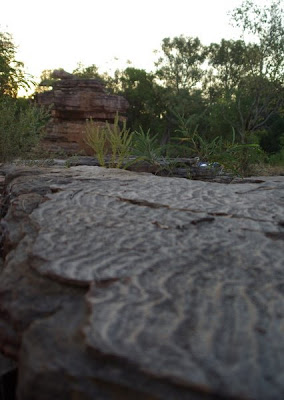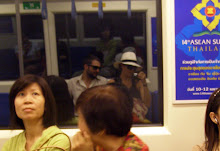
Here was our introduction to Australia:
11 PM: Fly out of Singapore's glossy metropolis (bye bye Asian odessey!)
4:30 AM: Stumble into customs line at Darwin airport (declaring all wood & spices)
5:30 AM: Arrive at Brett and Birgit's house – all of us strangers soon to become friends
6:00 AM: Shower. Unpack. Rummage through camping gear we shipped from Hawaii. Repack.
7:30 AM: Meet Clay's phd advisor and pile into jeep.
8:00 AM: “Go bush"
Most folks make the trip to Australia's "Top End" just to see Kakadu National Park, a world heritage site of sweeping savannas, Aboriginal rock art and the "escarpment" - an area of raised bedrock close to 2 billion years old littered with crazy stone formations and dissected by rain forest-filled canyons. The escarpment marks the western boundary of Arnhem Plateau...and the stopping point for most park visitors. But at 4 hours into our jeep trek, 8 hours into our new lives in Australia, when we lifted our travel-weary heads to take in the awesome lie of the stone country - the beginning of Arnhem Land - half of our journey still lay ahead.
Bound for Kolorbidahdah - an Aboriginal outstation about 5 hours past Kakadu. We were meeting friends of my professor, Joshua and his wife Reab, whose family's ancestral lands lie just beyond the settlement.
We spent 8 days at Dugalarjaraj, where a huge rock covered in artwork balances above a beautiful campsite in the sandsheet savanna bordered by a little set of pools on the Caldell river. Aborigines name specific locations, like Dugalajaraj, along watercourses, rather than the river itself - hence the whitefella name for the stream. Far from mere landmarks or lines on maps, however, named places on an Aboriginal homestead carry the weight of the country in stories - dreamtime tales of creation and ancestral spirits who still watch over the landscape - everpresent in the worldview of the caretakers - Joshua and his family.
Just to be able to visit this place - Dugalajaraj - is truly a gift. But with Joshua and Reab camped closeby, they also allowed to roam around the country unaccompanied to conduct fieldwork. This sounds nominal but is really a big deal. Aborigines worry about outsiders on their land - not for the damage we might do, but for our own safety. Their responsibility for us lies somewhere between asking for permission and for protection. Spirits both benign and malevolent inhabit this place, and their acknowledgment ensures the safe passage of guests.
It is difficult for outsiders to comprehend the degree of spiritual connection with country that some of the more fortunate Aborigines in Arnhem Land still posess. A few short minutes away from the outstation and it feels like the deepest wilderness you can imagine. But pay close attention and nestled everywhere among the otherwordly rock formations is artwork - clear signs of the hands of humans - Joshua's and Reab's ancestors - who have wandered this landscape for at least 50,000 years. Fifty-thousand years....just think about that.
 got to fly back to darwin over the savannas and croc-filled rivers that lead to the north coast
got to fly back to darwin over the savannas and croc-filled rivers that lead to the north coast  1,600,000,000 year old stones
1,600,000,000 year old stones 
termite mounds aligned with the earth's magnetic field

typical Australian savanna woodland - the trail's been made by feral water buffalo


green ants - very charismatic but they bite
 sunset time at Dugalajaraj
sunset time at Dugalajaraj
Ripples in the rock - evidence of shallow waters that covered the region millions of years ago
 more rocks
more rocks
carnivorous sundew plant

Joshua and Reab's son Leroy

"cleaning country" - Joshua and his family lit these fires after harvesting yams in the forest nearby

it seems strange to lots of people but many savanna species are adapted to survive fires - cleaning country with small, patchy fires like this prevents large wildfires later on and is probably the best way to manage the region's plants and wildlife.

No comments:
Post a Comment